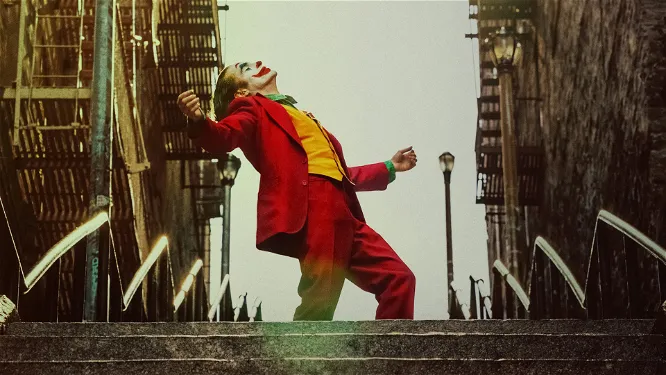Introduction to Joker (2019)
“Joker” is not just a film — it’s a cultural phenomenon. Directed by Todd Phillips and starring Joaquin Phoenix, “Joker” (2019) redefined what a comic-book-inspired movie could be. Rather than focusing on superhero battles, “Joker” presents a gritty, psychological character study that challenges viewers to confront uncomfortable societal truths. Premiering at the Venice Film Festival, “Joker” won the prestigious Golden Lion award and sparked widespread debate about art, violence, and mental health.
Table of Contents
“Joker” grossed over $1 billion worldwide, becoming the highest-grossing R-rated movie of all time. Joaquin Phoenix’s portrayal earned him the Academy Award for Best Actor, solidifying “Joker” as a landmark film of the 2010s.
Detailed Plot Summary
“Joker” follows Arthur Fleck, a marginalized clown-for-hire and aspiring stand-up comedian struggling with mental illness. Living in a decaying Gotham City, Arthur faces constant rejection, humiliation, and systemic neglect. His mother, Penny, insists that Thomas Wayne, a wealthy businessman, is Arthur’s father, propelling Arthur into a journey of discovery that ends in tragedy.
After a series of violent incidents — including Arthur killing three Wall Street employees in self-defense — Arthur’s descent into madness accelerates. Gotham’s underclass idolizes him as a symbol of resistance, while Arthur himself embraces the chaotic Joker persona.
The movie crescendos with Arthur’s live TV appearance on “The Murray Franklin Show,” where he fully transforms into the Joker, igniting city-wide riots.
Deep Dive into Joker’s Character: Arthur Fleck

Arthur Fleck’s character is a masterclass in psychological complexity. Suffering from pseudobulbar affect (PBA), a condition causing uncontrollable laughter, Arthur faces alienation daily. His longing for connection contrasts sharply with the cruelty he encounters, highlighting societal failure to address mental illness compassionately.
Joaquin Phoenix’s portrayal makes Arthur disturbingly relatable, exposing how external circumstances and internal struggles coalesce into violence. The audience is left questioning: was Arthur always destined to become Joker, or did Gotham create him?
Cast and Character Breakdown
Joaquin Phoenix as Arthur Fleck / Joker
Phoenix delivers a haunting, transformative performance, embodying Arthur’s vulnerability, rage, and eventual liberation through chaos.
Robert De Niro as Murray Franklin
A talk-show host who ridicules Arthur on live television, unknowingly pushing him over the edge.
Frances Conroy as Penny Fleck
Arthur’s mentally ill mother, whose delusions and neglect contribute to Arthur’s fractured psyche.
Zazie Beetz as Sophie Dumond
Arthur’s neighbor and imagined love interest, representing his desperate longing for normalcy.
Other supporting roles flesh out Gotham’s grim reality, each encounter driving Arthur closer to his fateful transformation.
See Also
- Bad Boys: Ride or Die (2024) – Ultimate Action, Cast, Plot, and Full Review
- Den of Thieves 2: Pantera (2025) – Full Review, Plot, Cast, and Everything You Need to Know
- The Brutalist (2024) Movie Review, Plot, Cast, and Everything You Need to Know
Themes Explored in Joker
“Joker” examines:
- Mental Illness: Arthur’s untreated conditions highlight societal indifference.
- Class Struggle: Gotham’s elite vs its disenfranchised.
- Identity Crisis: Arthur’s search for meaning and validation.
- Isolation: The crushing loneliness experienced by those on society’s margins.
The movie doesn’t justify Arthur’s actions but asks viewers to understand the environment that fosters such violence.
Visual Style and Cinematography
Director Todd Phillips and cinematographer Lawrence Sher used muted color palettes and 1970s visual references to create Gotham’s grim aesthetic. Shots of Arthur dancing in the bathroom or descending the now-iconic staircase symbolize his psychological shifts.
Lighting is meticulously crafted — Arthur is often isolated in harsh shadows, emphasizing his emotional state.
Joker’s Soundtrack and Score
Hildur Guðnadóttir’s score earned an Oscar for its chilling, cello-driven soundscape. Songs like Frank Sinatra’s “That’s Life” punctuate key scenes, adding irony and emotional complexity.
The score evolves with Arthur, starting somber and becoming more chaotic as he transforms into Joker.
Critical Reception and Box Office Success
Despite fears that “Joker” might incite real-world violence, the movie became a critical darling and commercial juggernaut. It earned 11 Academy Award nominations, winning for Best Actor (Phoenix) and Best Original Score (Guðnadóttir).
Audiences connected with its raw portrayal of alienation, and “Joker” ignited endless debate about the role of cinema in reflecting societal issues.
Joker Ending Explained
The ending is deliberately ambiguous. After Arthur is arrested, we see him in Arkham Asylum, laughing uncontrollably. Was everything that happened real, or a fantasy concocted in his mind?
Some interpretations suggest that much of “Joker” is imagined by Arthur, blurring the lines between reality and delusion — fitting for a character whose entire identity is shaped by societal neglect.
Joker’s Impact on Pop Culture
From memes of Arthur dancing down the stairs to intense academic discussions about its meaning, “Joker” left a permanent mark on pop culture. It challenged what superhero-adjacent cinema could achieve and influenced films like “The Batman” (2022).
Behind the Scenes: Making of Joker
The production faced budget restrictions, creative disagreements, and concerns about the film’s dark tone. However, Phillips’ commitment to his vision and Phoenix’s intense performance pushed “Joker” into cinematic greatness.
Controversies Surrounding Joker
“Joker” faced scrutiny for its depiction of violence and was banned in some theaters for fear of inciting unrest. Despite the controversy, or perhaps because of it, audiences flocked to experience the unsettling brilliance of “Joker.”
Joaquin Phoenix’s Transformation for This Movie
Phoenix lost 52 pounds for the role, transforming his physical appearance dramatically. His dedication to capturing Arthur’s pain and madness is evident in every frame, making “Joker” unforgettable.
Comparisons to Other Joker Performances
While Heath Ledger’s Joker in “The Dark Knight” remains iconic, Phoenix’s portrayal stands apart. His Joker is more grounded in reality, a product of societal neglect rather than a chaotic mastermind.
Gotham City: More Than a Setting
Gotham in “Joker” is almost a character itself — a decaying, cruel city that mirrors Arthur’s descent. Inspired by 1970s New York, Gotham feels oppressively real.
Psychological Interpretation of This Movie
Arthur displays symptoms of several psychological disorders: PBA, narcissistic delusions, and psychopathy. “Joker” serves as a dark mirror reflecting the dangers of a society that ignores its most vulnerable members.
Fun Facts and Trivia About This Movie
- Joaquin Phoenix improvised much of Arthur’s dancing scenes.
- Todd Phillips modeled the film after Martin Scorsese’s classics.
- The bathroom dance scene was unplanned, born from a spontaneous moment on set.
Conclusion: Why Joker (2019) Still Resonates
“Joker” (2019) remains a masterpiece because it holds a mirror to society’s darkest impulses. Joaquin Phoenix’s transformative performance, Todd Phillips’ daring direction, and the film’s unflinching themes make it one of the most important movies of modern cinema.
By daring to ask uncomfortable questions and presenting a villain as a tragic figure, “Joker” forces viewers to confront the consequences of a broken system — making it not just a film, but an experience.
Source and Reference
IMDB, https://www.imdb.com/title/tt7286456/



1 comment